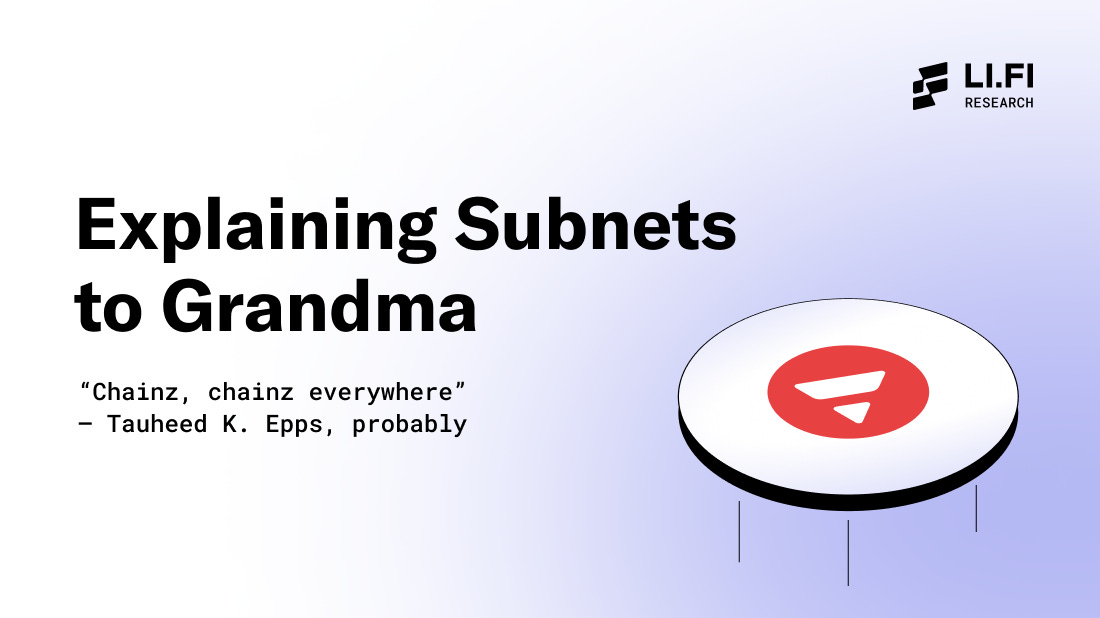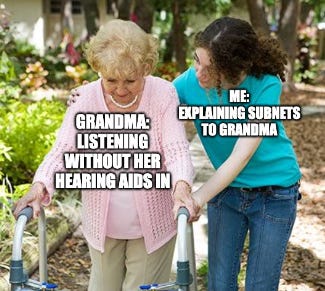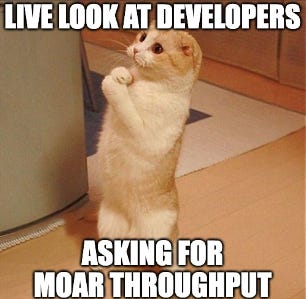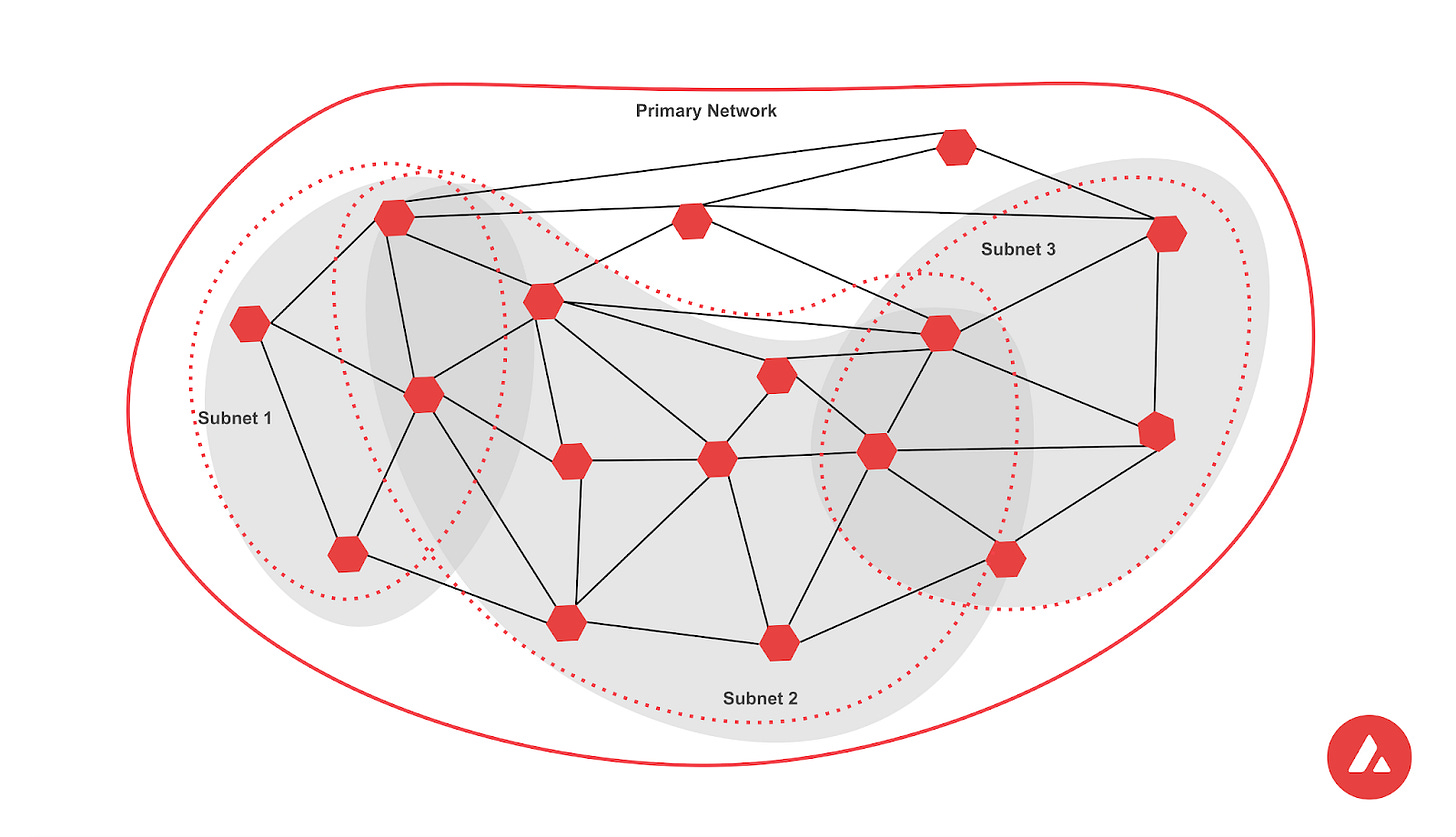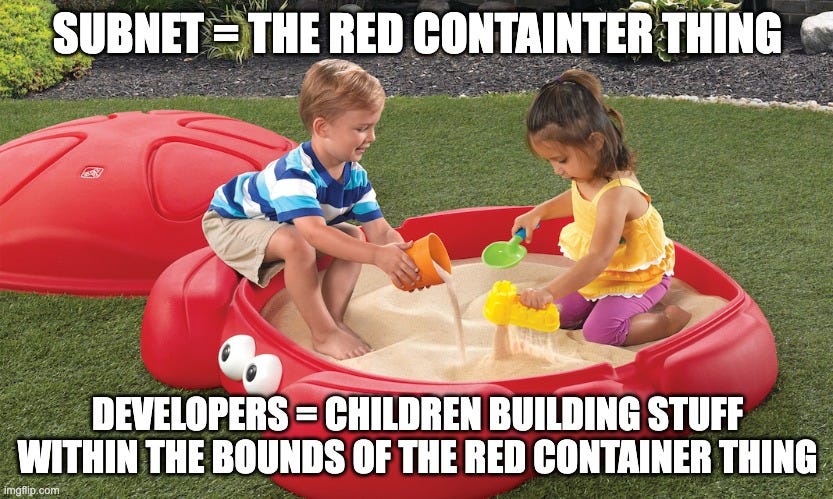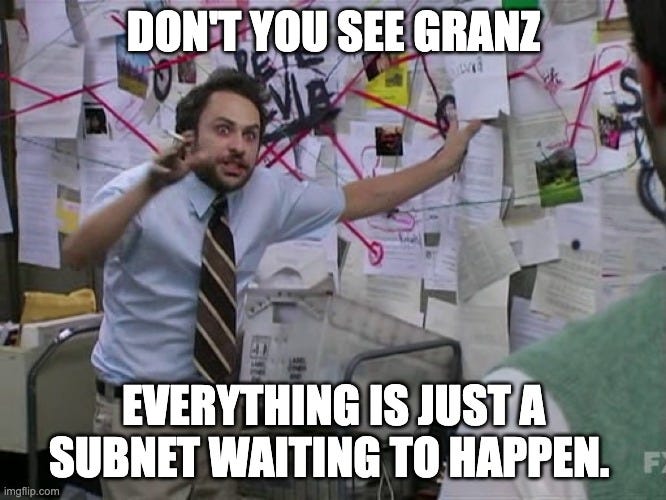Explaining Subnets to Grandma
FORWARD
The LI.FI team is working on a research piece covering Avalanche Warp Messaging, a new messaging primitive allowing Subnets to talk to each other (coming soon™).
However, we have yet to cover Subnets on this blog. To set the tone, we wanted to do a high-level overview covering WTF a Subnet Is before we go deep into the weeds on how Subnets communicate (which is the exciting stuff because, without a native messaging primitive, Subnets are just isolated blockchains with limited interoperability).
So here we are. Me, Kram, writing an article on Subnets for your Grandma. Let’s go.
INTRODUCTION
This is an article about Avalanche Subnets.
Let’s look at a few stats, draw two conclusions from these stats, and build a thesis to give you context as to why Avalanche Subnets exist in the first place (cuz in crypto there is always, ALWAYS, a thesis).
Stats Part 1:
17. The number of transactions per second Ethereum can handle.
4,500. The number of transactions per second Avalanche can process per second.
24,000. The number of transactions per second Visa can handle.
Conclusion #1: More Throughput is Necessary for Crypto Even Though Avalanche Is Doing Better Than Ethereum
While faster and cheaper than Ethereum, the base layer of Avalanche needs to scale significantly to match traditional demand. For example, far more than 4,500 transactions per second are needed to support large-scale payment rails (Visa alone does 24,000 tps) or gaming ecosystems (Call of Duty has 1-3 million daily active users). Just because Avalanche has out-scaled Ethereum does not mean it has solved anything meaningful quite yet.
Stats Part 2:
10+. The number of bridges connecting other chains to Avalanche.
35. The number of blockchains with $50+ million in value locked (deposited) into their smart contracts.
131. The number of decentralized applications (dApps) with more than $50 million in value locked into their protocols.
Conclusion #2: Developers Need Places to Develop Outside Ethereum and Avalanche
The crypto industry is home to a lot of blockchains, each with a unique community of applications, developers, and users. Across the crypto industry, 35 chains and 131 dApps hold more than $50 million in value, equating to a sector worth $50+ billion. dApps specifically are spreading across blockchains in search of environments with cheap gas and quick transactions so that developers have more leeway to build cool applications for users to enjoy. If crypto is going to go mainstream, both supply and demand for new places to make blockchain stuff will more likely increase than decrease. Multi-chain is not theoretical anymore; it is a reality and is currently the best way to scale blockchain throughput.
Thesis:
If crypto wants to scale, blockchains must scale so that developers can continue giving users access to applications with cheap gas and quick transactions. This means Avalanche needs to scale. And Avalanche knows this.
And so Avalanche built a scaling solution called Subnets directly into its core infrastructure! Subnets combine Conclusion #1 (needing more throughput) and Conclusion #2 (giving developers a place to build something cool) into a single solution that can be spun up quite easily.
AVALANCHE IS A SUBNET, SUBNETS ARE AVALANCHE
Let’s continue with some background on the relationship between Avalanche and Subnets.
Ok, so Avalanche
Avalanche is an EVM-compatible network (it works just like Ethereum) with a twist – it is made up of three unique blockchains that each have their own superpower.
Contract Chain (C-Chain): lets developers build dApps and other smart contract stuff in Solidity, the language of Ethereum.
Platform Chain (P-Chain): enables consensus via staking (proof of stake) for and supports the creation of subnets (more on both of these later).
Exchange Chain (X-Chain): allows users to move Avalanche Native Tokens.
Here’s how it looks (don’t worry if this looks like a calculus equation, I’m going into more detail in just a second):
When combined, C-Chain, P-Chain, and X-Chain create the “Primary Network” – which is what you probably think of when you think about Avalanche as a blockchain. The three-pronged approach helps reduce congestion on C-Chain (where smart contract interactions happen) and keeps Avalanche gas fees much lower than Ethereum.
This is great! But not good enough. Remember, crypto is trying to scale to match the payment and gaming giants of web2! A decrease in gas costs is just the start.
Ok, so Subnets.
An Avalanche Subnet is a sovereign (unique and under its own control) network. Each Subnet can define its rules – like how its gas token works, who can validate the blockchain, how many transactions it can handle per second, etc.
The only thing necessary for a Subnet to launch and be considered an Avalanche Subnet is for the Subnet validators to validate (aka stake) on Primary Chain.
Avalanche, the place where you spend AVAX as gas to make a trade on TraderJoe, is technically a Subnet. It is a Subnet that made rules like this: consensus/staking/execution are to be split into three different blockchains, AVAX is used for gas, consensus is gathered via proof-of-stake, and it requires 2,000 AVAX to become a validator on the network!
(If you are still confused, here’s a simile: as Subnets are to rectangles, Primary Network is to squares. Primary Network is a particular type of Subnet – just like the square is a particular type of rectangle.)
Each Subnet will have different rules for gas, consensus, and staking! (To continue the quadrilateral comparison, Subnets will have different-sized sides.) These rules will, Avalanche hopes, allow developers to build cool experiences that can span the gap between the Web2 throughput needs of companies like Visa and the limitations that blockchains inherently have (like having to pay gas fees and low transactions per second).
SUBNET SUPERPOWERS
Avalanche built its entire structure on Subnets, and Subnets helped Avalanche scale to 4,500 transactions per second in the first place (remember, Ethereum can only do about 17 TPS).
But Subnets are even more potent than what I just explained. Think about Subnets as smart contract blockchains that work right out of the box and can be programmed to a developer’s wants and needs – meaning that developers can theoretically create new blockchains with 10,000 TPS with little effort and, most importantly, not have to worry about the strict rules set by the Avalanche Primary Network.
In other words, a Subnet is an Avalanche-ish environment developers can use to custom-build a blockchain experience. A Subnet has carte-blanche to specify execution logic, determine a fee regime, maintain its state, facilitate networking, and provide security as a standalone blockchain.
To put that in English, Subnets are blockchains that can launch their own token, enforce KYC/AML checks for validators in the name of compliance, increase hardware requirements for validators, and tweak the Avalanche VM to better work for applications building on top.
The only reliance a Subnet has on the Avalanche ecosystem is that Subnet Validators must also validate on the Primary Network! This is a win-win-win for both Subnets and Primary Network and Primary Network Validators.
The design is good for Subnets because Subnet validators must be sophisticated enough and honest enough to validate Primary Network. Subnets are a good thing for Primary Network because Subnet builders will be incentivized to spin up their own validators (to take advantage of the Subnet-specific token model), which means Primary Network should see an influx of validators as more Subnets arise. And, for Primary Network Validators, Subnets are good because Primary Network Validators are able to up their rewards profile by securing Subnets (which usually offer token rewards via proof-of-stake for doing so).
Side Note: Subnets are a lot like Rollups in the Ethereum space. However, there is one main difference – Subnets do not share execution, storage, or networking with the Primary Network or any other Subnet (whereas rollups settle to mainnet Ethereum). This, for now, is an interoperability limitation that AWM might fix down the line.
INTERLUDE – LET’S EXPLAIN SUBNETS TO GRANDMA
Grandma break! Let’s explain this to Grandma.
Ok, Nana, let me throw some knowledge at you.
So, first off, we’re talking about blockchains, which already confuses you.
Just remember, a blockchain is like the internet but includes a really silly rule: you must pay for each click you make. The more complicated the click, the more money you have to pay.
And let me remind you that each blockchain has a limited amount of clicks that can happen per second. So the more click demand, the more each person has to pay.
Subnets are a way to decrease the cost per click while still using blockchain technology.
Think about Subnets like templates in Microsoft Word.
In this example, Avalanche is Microsoft Word. It is its own application, housing all of the cool features, tools, and users that have made Microsoft billions.
Subnets are like templates that Microsoft Word gives users to write cool things.
For example, there is a template for Resumes, Research Reports, Pamphlets, Cover Letters, etc. A template allows Word users to come in and build their own documents without starting from scratch!
In the same way, Subnets give developers various templates to build things on without having to start from scratch! Just like Word makes formatting a resume easy, Subnets make launching a blockchain easy.
And making the process of launching a blockchain straightforward is super important because we want more companies like Starbucks and Visa and Nike to come into the space and innovate! Subnets are one of the easiest ways to do so.
SUBNETS AND WHAT IS BEING BUILT
A Subnet is a perfect environment for projects that want authority over one of the following things:
Tokenomics: control over what token users pay gas with
Block Space: higher or lower transaction throughput than Primary Network
Access: whitelisting or permissioned access to launching smart contracts
Execution (Virtual Machine for the nerds): execution parameters, aka the rules for how a blockchain does transactions
For those keeping track at home, having authority over one of the four characteristics above unlocks many potential use cases. Off the top of my head, I can rattle off quite a few (let’s rant to g-ma a bit more cuz now she kinda gets it):
Ok Nanz, NFT projects could launch a Subnet for its minting process to not disrupt the gas price on Avalanche’s Primary Network.
An order book DEX could launch a Subnet to bring high-frequency trading to the Avalanche ecosystem.
Web2 games looking for a high throughput blockchain could spin up a Subnet instead of building a game around the restrictions found on Primary Network.
Traditional companies like Starbucks or airlines could mint loyalty points on a Subnet, allowing them to decrease gas fees as much as they like.
Alright, so that is the theory of Subnets.
Now is a good time to talk about what is actually being built. There are already 21 examples of things being built as Subnets so far.
Here are a few highlights:
DeFi Kingdoms – launched initially on Harmony, this web3 gaming project launched an Avalanche Subnet called Crystalvale to better facilitate its user experience. Users can play a wonderful game on a blockchain customized for the game, rather than just general DeFi.
Crabada – the Swimmer Network Subnet allows users to play Crabada, one of my favorite games in the entire space, without worrying about paying high fees or waiting for a transaction to confirm on Primary Network.
Dexalot – a decentralized exchange allowing users to trade with low fees and fast transactions.
The Blitz App – TSM, a competitive gaming platform, is launching as a Subnet to make digital asset storage, sale, and purchase as smooth as possible.
Also, Avalanche is working with Aave to build an institutional DeFi experience for users on Subnets. Other TradFi firms like Jump, Valkyrie, Wintermute, Sercuritize, and GoldenTree are also listed on their website as Subnet buildooors, though no further information is known at this time.
THE BUT
There is always a but. Sorry. Here are four limitations of subnets:
Subnets cannot natively communicate, meaning each Subnet needs a bridge to move liquidity between chains (though this will change soon, thanks to AWM).
Centralization is a real risk when building permissioned Subnets, and users/developers should be wary if/when chains promise too good to be true throughput with a tradeoff of identity.
Subnet growth does not necessarily do anything for the Avalanche ecosystem at large.
Subnets must compete with dAppchain ecosystems like Cosmos, Polkadot, and RollApps as the go-to place for teams building unique, blockchain-specific experiences.
CONCLUSION
Besides “the but”, Subnets are a unique solution to scaling blockchains to meet traditional demand.
A Subnet gives developers a near blank slate to create a new blockchain in any dimension they want without starting from scratch from either the validator or execution standpoint.
In essence, Subnets are a plug-n-play method for developers to build cool, real-world use cases on top of.
That’s awesome.
Now, like everything else in this space, Subnets need to be interoperable.
This is why Avalanche Warp Messaging is being invented. AMW should let Subnets send messages to each other without using a third-party bridge.
That’s exciting. We’re going to write about it. And then also write about how Subnets can be plugged into the rest of the crypto ecosystem at large (cuz Subnets talking to Subnets is not enough, Subnets need to be able to talk to other chains like Rollups on Ethereum).
And then we might also write something comparing Subnets to Cosmos dappchains to Polkadot Parachains to Optimistic Superchains because that sounds super interesting.
But, for now, just send this to your grandmother and be like, “yooo, G, subnets are so cool. Can u send me $100 so I can spin up a derivatives platform on Subnet called G-Chain?”
- kram
(special thanks to Arjun Chand for his patience and editing skillz)
Get Started With LI.FI Today
For more information about the LI.FI protocol,
Head to our link portal at link3.to/lifi
Read our SDK’ quick start’ at docs.li.fi
Join the official Discord server
Follow our Telegram Newsletter
Subscribe on our Substack
or try our any-2-any swaps NOW at jumper.exchange



